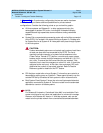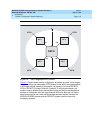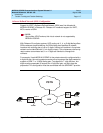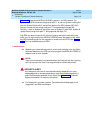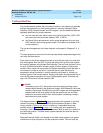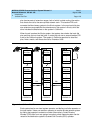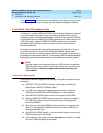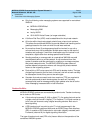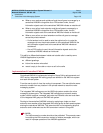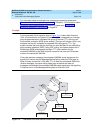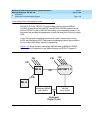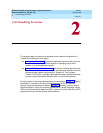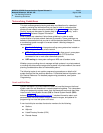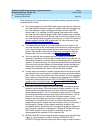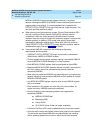
MERLIN LEGEND Communications System Release 6.1
Network Reference
555-661-150
Issue 1
August 1998
Introduction
Page 1-23Centralized Voice Messaging System
1
■ When a user receives and outside call and the call goes to coverage by a
centralized VMS/AA using either tie or PRI tandem trunks, the call
information signals sent to the centralized VMS/AA indicate an outside call.
■ When a user calls a local extension and the call goes to coverage by a
centralized VMS/AA using either tie or PRI tandem trunks, the call
information signals sent to the centralized VMS/Aa indicate an inside call.
■ When a user calls a non-local extension and the call goes to coverage
across the private network:
— If a tie tandem trunk is used to route the original call or to route the
coverage call over the private network to the centralized VMS/AA, the
call information signals sent to the centralized VMS/AA indicate an
outside call.
— If an all PRI routing is used, the call information signals sent to the
centralized VMS/Aa indicate an inside call.
This ability to differentiate between inside and outside calls is used by some
VMS/AA applications to provide:
■ different greetings
■ inform the receiver who called
■ record a reply to the caller or return a call to the caller
Implementation of Centralized VMS/AA 1
Centralized VMS/AA is implemented using the Group Calling enhancement and
UDP routing. Integrated VMI calling groups are defined on the VMS hub system
and each remote system.
From the user’s point of view, the routing is transparent. The user dials the same
extension number from any location in the private network to reach the voice
messaging system.
The integrated VMI calling group on the VMS hub system contains the voice
messaging system ports. The integrated VMI calling groups on each remote
system receive overflow, coverage, and voice mail retrieval calls and route them
to the integrated VMI group on the VMS hub system.
Routing to the centralized VMS/AA is done by assigning a single non-local
extension as a member of the integrated VMI calling group at each remote system
sharing the centralized VMS/AA. This extension has no corresponding physical
extension and is referred to as the
VMI conversion number
in this guide.
NOTE:
The VMI conversion number should not be published. This prevents users
from dialing the VMI conversion number to retrieve messages, which can
result in improper operation of the VMS/AA application.



